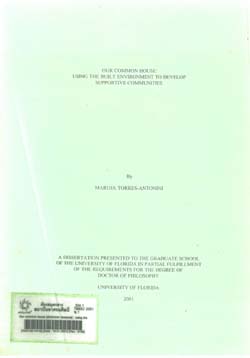|
| ผู้แต่ง |
Torres Antonini, Maruja | | ชื่อเรื่อง |
Our common house using the built environment to develop supportive communities / by Maruja Torres-Antonini. | | ชื่อเรื่องที่แตกต่าง |
Using the built environment to develop supportive communities | | เลขเรียก |
334.1 T693O 2001 | | ลักษณะทางกายภาพ |
Document formatted into pages; contains xv, 263 p.; also contains graphics. ; 30 cm. | | หมายเหตุ |
Document formatted into pages; contains xv, 263 p.; also contains graphics. UF | | หมายเหตุ |
Summary: ABSTRACT: Awareness of the need for alternative community models that are socially and ecologically healthy has led some Americans to try cohousing, where a renewed ^"sense of community^" and a move toward environmental stewardship are encouraged through design and everyday practices. In cohousing, individual households join to create a community by participating in the design and administration of the common property, sharing tasks, assisting each other, gathering for communal meals, and establishing a social network reminiscent of extended family structures. Further dissemination of cohousing requires understanding its model. Of particular interest is finding out whether and to what extent the physical patterns of cohousing communities contribute to advance residents toward more sustainable and socially healthier living. Substantial and continuous reference to ^"social contact design^" as an essential component of cohousing suggests that specific physical features of these communities--increased density, inward-facing layouts, grouped structures and emphasis on pedestrian circulation--may be a way to represent, encourage or channel the social interaction sought by their residents. This research used an action research process to examine the cohousing model and to explore the linkages between its social and physical patterns. It relied on qualitative formal analysis of architectural drawings and photographs to describe the physical setting of a case study community and on experiential methods such as participant observation and interviews to document the behaviors of its residents. | | หมายเหตุ |
Abstract: 02 ABSTRACT (cont.): The inquiry centered on the desired interaction and on the design features of the community involved in the development and consolidation of any of those behaviors. The linkages between the social and physical patterns observed in the case study community are explained in light of environment-behavior theories. Results showed that the social contact design strategies implemented in the case study community facilitate social contact among neighbors and foster feelings of safety within the community; and to some extent contribute to existence of a neighborhood support network and allow residents to participate in community governance and maintenance. Results suggest that cohousing may be a viable model for creating socially and environmentally healthy neighborhoods with a sense of community. UF |
|

 แสดงรายละเอียดบรรณานุกรม
แสดงรายละเอียดบรรณานุกรม ขอยืม
ขอยืม


